|

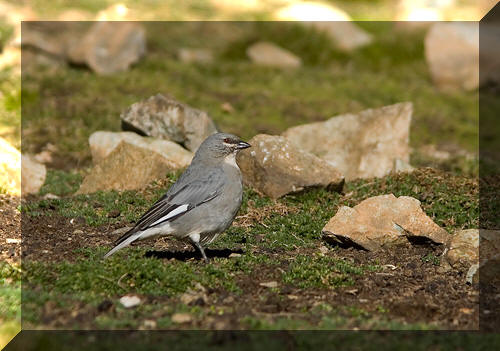
White-winged
Diuca-Finch (Hvitvingespurv); Ticlio Pass
| |
|
Rapporten som presenteres
her er skrevet
av Roger Ahlman og er også publisert på Kolibri Expeditions'
hjemmeside:
http://www.kolibriexpeditions.com/upload/trips/Central
Peru 24[1].9-12.10 06.pdf.
Observasjoner fra Santa Eulalia Valley er utelatt.
Uheldige omstendigheter førte til at jeg og Morten måtte forlate
Roger og Ron på Milloc Bog. De fortsatte nedover Santa Eulalia Valley
mens vi fulgte Gunnar Engblom til Lima og flyplassen. Vi så ikke mye
denne dagen, men det lille vi så er flettet inn i artslisten. Det ble
ikke ført logg for pattedyr på denne turen. Lite, annet enn lama og
vikunja, ble sett. |
|
|
|
Litteratur:
| |
|
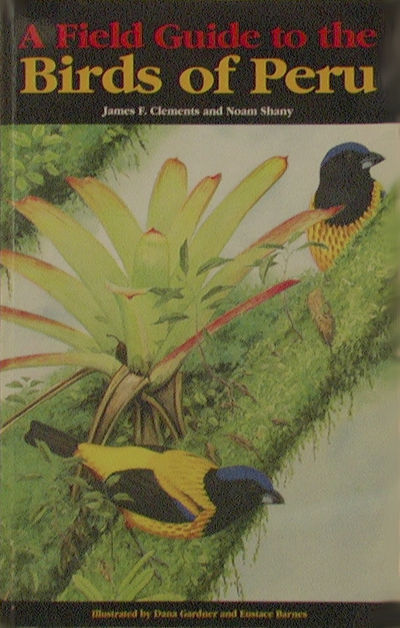 |
"A Field Guide to
the Birds of Peru"; James F. Clements & Noam Shany 2001.
En svært viktig felthåndbok som dessverre skuffer. Alle arter
er illustrert men kvaliteten på plansjene varierer fra ypperlig
til ekstremt dårlig. Dessuten er det stort sett kun hanner som er
illustrert. Boken har kortfattet og lite informativ tekst og
mangler utbredelseskart. |
|
|

|
| |
1:
2:
3:
4:
5:
6:
7:
8:
9:
10:
11:
12:
13:
14:
15:
16: |
|
Lima
Lomas de Lachay
Ventanilla
Carpish Tunnel & Paty
Trail
Tingo Maria
Bosque Unchog
La Quinua
Lake Junin
Villa Rica & Lake
Oconal
Oxapampa & Antenna
Road
Yanachaga-Chemillen
National Park
Puzozo
Road from Yarinaki to Satipo
Satipo
Satipo Road
Ticlio Bog & Milloc Bog
|
Reisen dag for dag:
Central Peru 24 sep - 12 oct 2006
Lomas de
Lachay, Ventanilla, Central Highway, Carpish, Paty Trail, Tingo Maria,
Bosque Unchog, La Quinua, Lake Junín, Oxapampa, Antenna Road, Lake
Oconal,
Yanachaga-Chemillen NP, Satipo road & Ticlio/Milloc
General:
This trip was organized by
Kolibri Expeditions. The weather was generally good but snow at Junín
and some rain in the mountains was disturbing on a few occasions.
The waterlevel in lake Junín
had gone down a lot the last weeks before the trip and it was not
possible to get out by boat and the lake is very shallow so it wasn’t
possible to see the Grebe from the shore either. A major dip! On the
east slope subtropics we encountered many signs of breeding including
several recently fledged birds as well as adults carrying food. Thus
the bird activity was rather slow and we didn’t encouter many big
flocks and song activity was rather poor as well. Despite this we
recorded 532 species including five that are still to be described.
Leader - Roger Ahlman
Co-leader - Alex Duran (part of the trip)
Participants - Leif Gabrielsen and Morten Nilsen, Norway
Ron Berkhout, Holland
Driver - Adriano
Chef - Renzo
Itinerary:
24 sep -
We all
arrived late last night and left Lima at 6 am for Lomas de Lachay. As
usual it was foggy up here but we soon found Least Seed-Snipe and
Coastal Miners along the entrance track as well as a pair of Peruvian
Thick-knees. Breakfast at the visitor centre and then we did a walk
along the trails that produced the endemic Thick-billed Miner and also
Band-tailed Sierra-Finch and Black-lored Yellowthroat. Then off to the
dry side. Near the big roundabout we spotted Tawny-throated Dotterels
and surprisingly one bird had two downy chicks so they obviously breed
here! In the dry valley we scrambled up the slopes flushing a pair of
Band-winged Nightjars and soon found some Cactus Canasteros. Happy
with this we returned to Lima and the suburb Ventanilla for some
wetland and coastal birding. The usual selection was available but a
female Purple Martin was a bit of a surprise. After some business in
Lima we sat off for a long night in the van to Huanuco...
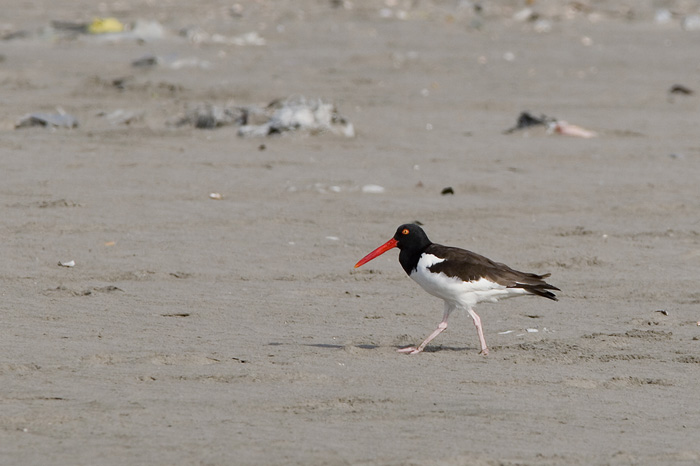
25 sep -
We arrived at
the Carpish tunnel at 6 am and started birding directly. Chestnut- and
Bay Antpittas were calling and we saw a few other birds before
breakfast. A longer walk gave us Barred Fruiteater, Unstreaked
Tit-Tyrant and a family of Powerful Woodpeckers among other things,
before the rain started. We waited a while before heading down the
mountain to Tingo Maria. En route we picked up a pair of Fasciated
Tiger-Herons in the river. A lunch break just before Tingo gave six
Blue-headed Macaws. We spent the afternoon near the Oilbird cave,
which was productive. Some highlights include Huallaga Tanager,
Golden-collared Toucanet, a family of Double-toothed Kite and
Lafresnaye´s Piculet. At dusk we took position at the cave to see
several hundreds of Oilbirds flying out. Night at the nice Villa
Jennifer just outside of Tingo Maria.
26 sep -
We started to
bird around the lodge before breakfast but it was rather slow with
Limpkin and Orange-backed Troupial being highlights. After breakfast
we went to the Santa Rosa bridge but it was already starting to get
hot and the surroundings were not very nice. Some 10 Hoatzins were
easily seen here. After some shopping we headed up the mountain again
to the famous Paty trail where we installed ourselves in an empty
house. We headed down the trail but hadn’t gone far before Leif
realized that his binoculars were not around his neck! Had he forgot
them in the van or outside? He went up but the car was gone and no
bins! Afternoon birding was rather slow but we had good views of
White-eared Solitaire, Peruvian Tyrannulet, and a pair of Uniform
Antshrikes among others. Back at the road the car was back with Reyes
Rivera, who was to help us at Bosque Unchog. To Leif’s relief his bins
were in the van.
27 sep -
We went down
Paty trail again and activity was better with many highlights such as
Gray-breasted Mountain-Toucans, 3 Masked Fruiteaters, Bar-bellied
Woodpeckers, Buff-browed Foliage-gleaner and Emerald-bellied Pufflegs
to mention a few.
After lunch we drove to Bosque Unchog and on the way up we had good
views of a Curve-billed Tinamou. While Adriano and Reyes sat up the
camp, the group went for a recce. Not too many things but Coppery
Metaltail and Red-rumped Bush-Tyrant went onto the list.
28 sep -
Today we started walking at 6 am and hit a flock
along the steep trail into the main valley. Pardusco and other
tanagers were in the flock. I played Yungas Pygmy-Owl to distract the
birds and soon the rare Rufous-browed Hemispingus came in. We spread
out in the valley to look for the Golden-backed Mountain-Tanager and
did that until Reyes came back with a late lunch and then it started
to rain so we went back to the camp. We saw all of the other birds
here including gripping views of Bay-vented Cotingas but the tanager
failed to show.
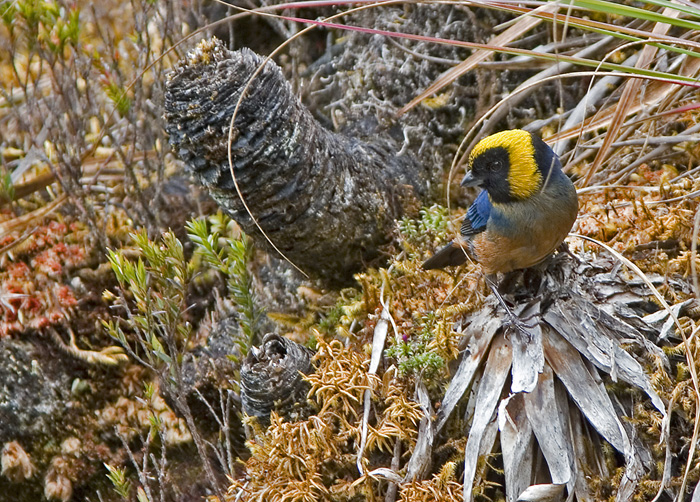
29 sep -
Another try for the Golden-back. The Hemispingus
showed again on the way down. Despite good weather and five people
searching we had to leave without the Golden-backed Mountain-Tanager.
Highly disappointing! On the way down on the try slope we found a pair
of the endemic Brown-flanked Tanager as a consolidation before
continuing to Huanuco and a welcome shower after three days camping.
30 sep -
We left Huanuco at 6 am and
drove for about an hour before stopping at a stake-out for
Rufous-backed Inca-Finch. It didn’t take long before we had that one
bagged. Another hour in the van took us to La Quinua, which is
surrounded by very nice dry polylepis forest. A couple of hours here
gave Thick-billed Siskins, Striated Earthcreepers, Baron’s Spinetail
and confiding Streak-headed Antpittas.
After lunch we headed up to lake Junín and tried for the Grebe from
the shore but it was a bad heat-haze so we went to the other side and
arranged with a boat for tomorrow. On the way back to Junín it started
to snow!
1 oct -
Back to Ondores where we had breakfast and the
boatmen were waiting. The Norwegians didn’t want to go out with the
boat so they spent the morning birding along the road and taking
pictures. Ron and I walked out towards the lake with two locals. As we
came closer to the lake it got muddier and the boat was in the mud as
well. We pushed the boat for about half an hour before we realized
that this didn’t work, the water level was simply too low. A
disappointing walk back to Ondores and we picked up the Norwegians and
went to the other side to give it a last try but no joy. Instead we
started a long drive down the mountains to Villa Rica where we spent
the night.
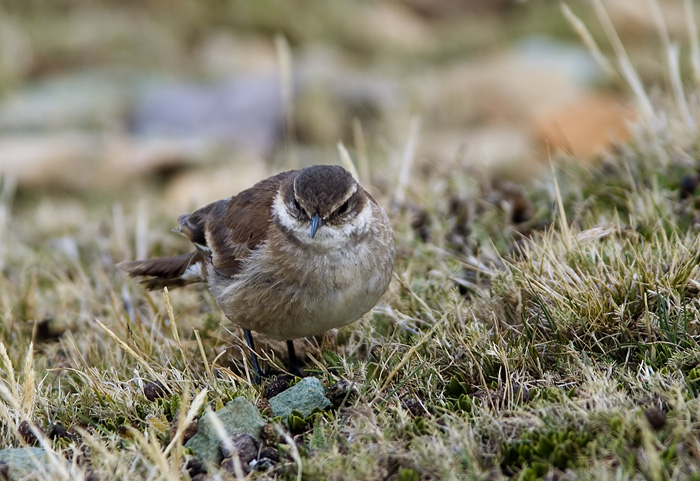
2 oct -
We left early for the relatively new road to
Oxapampa. Near the pass we stopped for breakfast and one of the first
birds we saw was a Chestnut-crested Cotinga! Also a pair of Vermillion
Tanagers and Long-tailed Antbird were seen before breakfast. We had
just finished breakfast when a heavy rain put a halt to birding for
about an hour. We walked down the mountain on the far side of the pass
picking up more Cotingas, Blue-banded Toucanets, breeding
Maroon-chested Chat-Tyrants and Green-fronted Lancebill. Lunch in
Oxapampa then to the local cheese factory for stocking up on good
cheese. In the early afternoon we headed up towards the Antenna road
but there was a strange sound from the car and Adriano was not happy
with that so we turned back to Oxapampa and had it checked - and that
was lucky! Something underneath the car was completely worn out and
had to be changed. Not good for the plan but I hired a taxi to take us
up to the pass again for some afternoon birding and we stayed there
until after dark trying for Owls and Cloud-forest Screech-Owl in
particular but it was quiet despite a nice evening. Night in Oxapampa.
3 oct -
An early start for the
Antenna road which took an hour and a half. It was very quiet up here
except for Scaly-naped Amazons. I trolled with the tape for the
Antpitta (Rufous or Chestnut?) that lives here. After a while one
started to call, this one is certainly a separate species. We walked a
little bit more and taped out a Trilling Tapaculo but soon gave up as
no action was going on here. At the bottom of the road Alex was
waiting and he joined us for the rest of the trip.
The road to Pozuzo cuts through the lower parts of the
Yanachaga-Chemillen NP and we walked a large part of this road.
Highlights here included Amazonian Umbrellabirds, Wedge-billed
Hummingbird and Black-throated Toucanet. Before dusk we stopped near
Pozuzo to try for overflying Blue-headed Macaws and we saw 4. In the
river were Sunbittern and Fasciated Tiger-Herons.
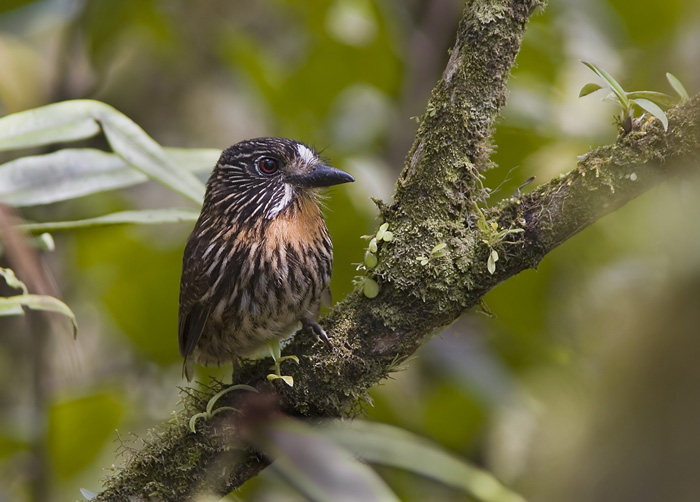
4 oct -
An early start for the Cock-of-the-Rock lek
nearby. Good action with at least twelve males displaying. In the
garden of the property were a Peruvian Tyrannulet and a
Sapphire-spangled Emerald. I was given a homemade cigar, which was
good. Back towards Oxapampa but with more time in the national park.
Birding was rather slow but we picked up three more Umbrellabirds, 3
Black-streaked Puffbirds and a very cooperative Lanceolated Monklet.
Gray-mantled Wren and Ocellated Piculet were other goodies here. More
problems with the car, this time it was the starting engine that
didn’t work so we had to push the car to start it. Adriano took care
of this in Oxapampa. Another night in Oxapampa.
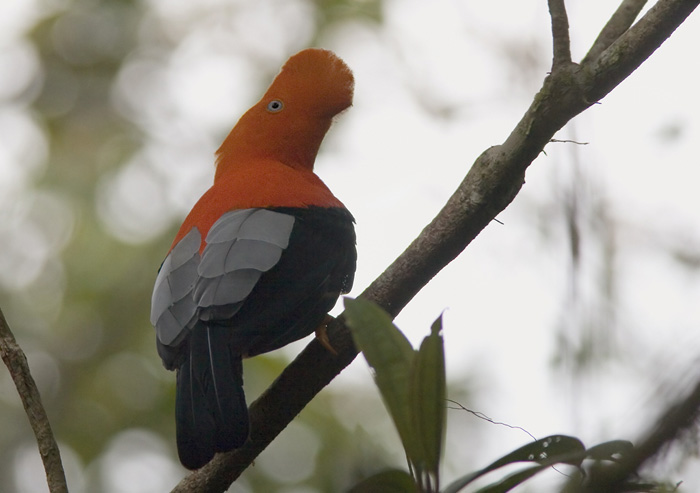
5 oct -
Once again back on the road to Villa Rica and we
stopped for birding/breakfast at the same place as last time. This
time some saw Bay Antpitta and all of us saw Red-ruffed Fruitcrow and
Red-crowned Parakeet. As we had a lot of ground to cover today we
couldn’t spend as much time as we wanted on each site. Down in Villa
Rica we went to the nice lake/marsh called Oconal. Soon we picked up a
Blackish Rail and some Herons and many Least Grebes. An Olivaceous
Greenlet was elusive but was eventually tracked down. Then towards
Yurinaki with
stops along the way that produced Pearly-vented
Tody-Tyrant, Cabanis’ Spinetail and Forest Elaenia among others. Down
at Yurinaki by the Río Perené we had lunch and birding by the river.
Leif scored the price-bird here - a White-rumped Swallow probably
migrating south. At the river it was very hot but we saw Barred
Antshrikes, Purple-throated Euphonias and Little Ground-Tyrant.
Towards Satipo there was supposed to be a site for Lyre-tailed
Nightjars and we stopped there for some afternoon birding while
waiting. Ron had some unbelievable luck here; an Andean Laniisoma was
sitting in a lone tree before flying off over the river! We hardly
believed him but soon found a Striolated Puffbird and both
Rufous-bellied- and White-lored Euphonias in some other trees!
Strange! No Nightjars showed up so we went to Satipo only to find out
that this was the Anniversary Day of the town and the party was in
full swing - just outside our hotel! After dinner it started to rain
heavily and it got silent to our relive.
6 oct -
We drove
about an hour up the Satipo road to Mariposa where we had breakfast
and took shelter from the rain. Adriano went back to Satipo to fix the
car properly. When the rain eased we started walking up the road in
rather poor habitat and activity was rather slow as well. Later we
came across a decent flock that had Blue-browed- and Golden-eared
Tanagers among other while an adult Black-and-chestnut Eagle flew
over. The car came back in the afternoon and we went up to Apaya
village at 2200 m and found an empty house to camp in. In the evening
we heard a couple of Lyre-tailed Nightjars nearby.
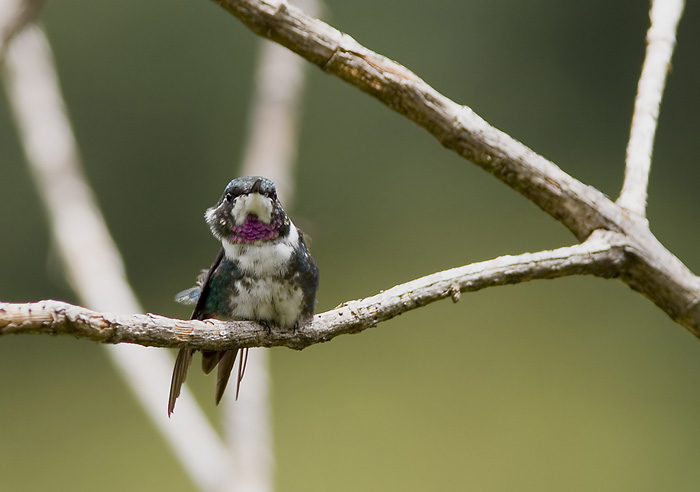
7 oct -
Today was to
be a rather exciting day despite some rain. We drove straight up to
the Carrizales bridge area and soon found Fire-throated Metaltail and
a diverse flock. We tried hard to find the recently re-discovered
Eye-ringed Thistletail but only heard one up the slope. After
breakfast we continued our search and eventually found a nest-building
pair that gave good views. Sadly the bamboo habitat here is being
destroyed for growing potatoes. We continued on the road to Andamarca
and stopped at a stake-out for the undescribed Millpo Tapaculo. The
weather was not what we wanted at 4000 m but with the tape one
responded and we scrambled up the slope and got good views of it. Two
Andean Ibises were in the marsh below. Then off to the next stop some
kilometers away. Immediately we saw a nest of the undescribed
Thornbird here but no birds. I played the tape of the undescribed
‘Mantaro’ Wren and they responded. We went there to search for them
but were held up by a flock. Ron and I scrambled up the brushy slope
and caught up with them and soon saw the Thornbird and the recently
described Black-spectacled Brush-Finch and also Creamy-crested
Spinetail. Nice! After lunch it stopped raining so we went up there
again and had very good looks at the Brush-Finch but the activity was
rather poor in the sunshine. Later we drove down to Pucacocha and
checked in at the school. An Aplomado Falcon flew by and perched
nearby. At dusk the ‘Apurimac’ Screech-Owls started calling nearby and
we tracked down one with the flashlights. The result for today was 4
undescribed (sub)species, one recently described and one recently
re-discovered - not bad!
8 oct -
We woke up to the
sound of the Screech-Owls and packed up and took another route back to
the Satipo road. The breakfast break above the village didn’t produce
anything special so we continued until I heard the new Wren singing
near the road so we stopped and taped them out. We continued across
the puna to the Satipo side of the pass where some impressive bamboo
took over and started birding there. Leif got a view of the obscura
race (or species) of the Rufous Antpitta. Several Unstreaked
Tit-Tyrants were seen before we caught up with a flock that had the
very recently discovered new ‘Light-crowned Spinetail’ that Gunnar has
recently found here. Almost certainly a new species! We taped out a
Large-footed Tapaculo, they sound very different here from at Bosque
Unchog and a split is very likely. Good birding down to Apaya along
this new road. In the evening we tried a new site for Lyre-tailed
Nightjar that looked good. At dusk a male called and two females were
flying around and a male put in a short appearance. Night in Apaya
village.
9 oct -
We started
birding a bit lower down from Apaya and walked the road downhill.
Rather slow birding and annoying with the rushing river next to the
road. We had some flocks but not much new until we found two Inca
Flycatchers. Then came the rain. We waited a while then drove down to
Mariposa and had lunch and waited for the rain to stop, which it did
around three in the afternoon. The walk down from the village produced
quite a few birds in the late afternoon, among them a male
Umbrellabird, Bluish-fronted Jacamars and Black-faced Tanager to
mention a few. Night in Satipo.
10 oct -
We started at
the rice-fields just out of Satipo and were greeted by two Pearl Kites
while Rufous-sided Crakes were calling and we had brief views of two.
Lineated Woodpecker and calling Tataupa Tinamous were also new for the
trip list. After breakfast Leif took pictures of a Black-billed
Seed-Finch. We did some playback and a male and two females came in.
We had a long drive ahead of us so we sat of and made some stops along
the river Perené that gave Yellow-billed Tern, Pied Lapwings and
Fasciated Tiger-Heron. After lunch in San Ramon we tried the road to
Pampa Hermosa but with full sunshine and heat in the midday it was
bound to be slow - and it was. We did pick up Coraya Wren and
Streak-chested Antwrens before heading for La Oroya where we spent the
night.
11 oct -
From
La Oroya it is about an hour to the Ticlio bog at 4500 m. Before
getting out of the car we saw the endangered White-bellied Cinclodes.
A short walk here gave 7 in total and also the much-wanted Diademed
Sandpiper-Plover. Also both Rufous-bellied- and Gray-breasted
Seedsnipes and four species of Ground-Tyrants. After breakfast we went
to the Milloc bog and had three more DSP as well as both
Slender-billed- and Dark-winged Miners. After a while an Olivaceous
Thornbill put in a nice show when it literally jumped on the ground
from flower to flower. Gunnar showed up and took Leif and Morten down
to the airport while Ron and I continued to the
polylepis in the
upper Santa Eulalia valley.
Coming here in the afternoon is not ideal but we
did see Canyon Canastero, Black Metaltail and Striated Earthcreeper
among others but no White-cheeked Cotinga. Sadly we found several
trees recently cut down. On the way down we passed no less than seven
donkeys loaded with polylepis wood. If this continues the
forest here will soon be too degraded to hold the good birds tied to
the unique polylepis. Lower down in the valley we found two
Spot-winged Pigeons and a Great Inca-Finch. Night in Santa Eulalia
village.
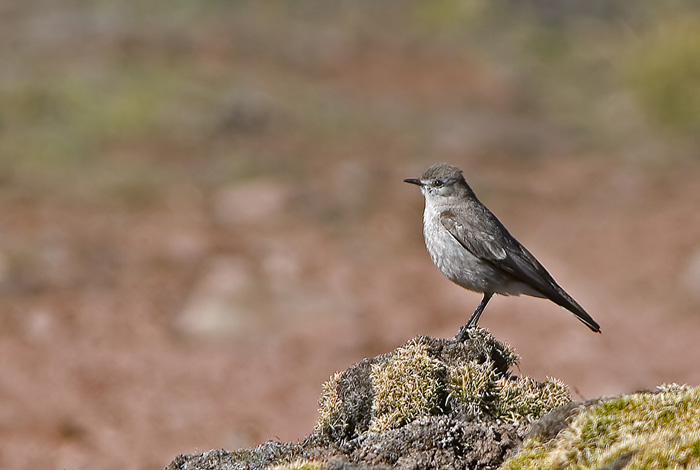
12 oct -
We left at 5 am and drove straight up to the San
Pedro de Casta area. We soon saw some Andean Tinamous walking away
from us. Rusty-bellied Brush-Finch and Mourning Sierra-Finches were
very common. After breakfast we went up the slope and tried for
Rufous-breasted Warbling-Finch for which this site has been a good
stake-out but no luck. In fact it hasn’t been seen here this year! A
water-hole up the slope had hundreds of Eared Doves and Black-winged
Ground-Doves and a flock of Greenish Yellow-Finches. A brief view of a
Bronze-tailed Comet and Ron also saw a Black-necked Woodpecker. It
felt slow so we moved down a bit trying to get better views of the
Comet but instead got good views of Peruvian Sheartails. It was
getting hot and birding was slow. After a late lunch in Huinco we just
made a few more unproductive stops before calling it an end to the
trip and went back to Lima.
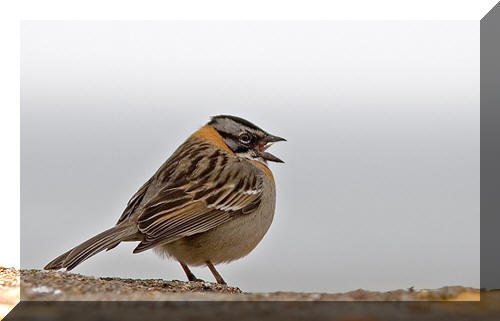
Rufous-collared Sparrow
(Rustkragespurv); Junin
>
Artsliste (Species list)
>
Fotogalleri (Kommer
senere)

|